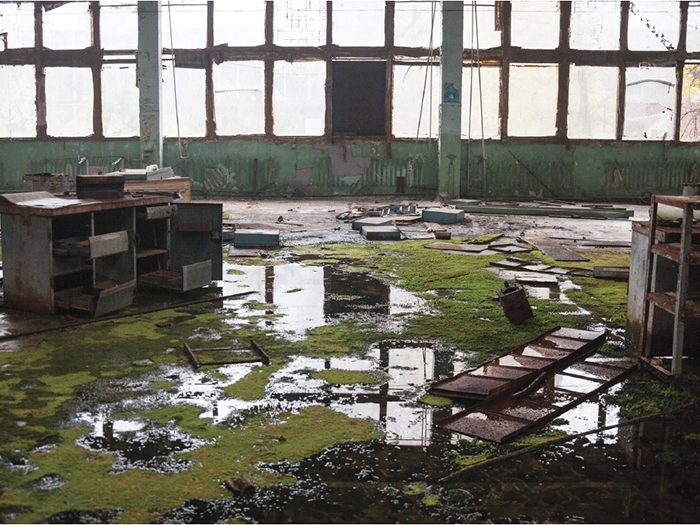Environmental
Disasters Leave a Toxic Tail

The year 2017 was a bad year for named storms. Hurricanes Harvey, Irma and Maria caused widespread property damage and loss of life. While refineries and chemical plants were secured, pollution and contamination from agricultural and pool chemicals as well as fuels and lubricants could be seen far and wide.
“Since the Murphy Oil release during Hurricane Katrina, heavy industrial facilities at risk have developed stronger preparedness and storm contingency plans,” said Marcel Ricciardelli, senior vice president of environmental, design, professional and surety, Allied World.
“A single major release can result in extensive damage.”
While no Murphy Oil-scaled events occurred, 2017 saw tank roof collapses, fires and explosions, air pollution releases, spills and waste site flooding. To add historical context, Hurricane Sandy, which hit in 2013, resulted in similar types of releases from flooded vehicles and underground/aboveground storage tanks.
“Major changes in building codes or government regulations would likely be needed to harden small businesses, commercial buildings, homes and vehicles,” said Ricciardelli. “The key question is whether the cost and effort would help to reduce releases significantly.”
He added, “I believe that it has been most effective to plan for worst-case scenarios, using preparation time to remove hazardous materials and to develop contingencies for critical services. Unfortunately, there is a lack of predictability with regard to weather intensity and flooding.”
Planning for Contaminants
Flooding is a broad peril with the ability to move pollution.
“Without the ability to prevent flooding, it is difficult to prevent possible contamination from flood waters,” said Ricciardelli. “Flood water can be contaminated from sewage overflows, waste sites, releases from mechanical systems, energy infrastructure and materials in the chain of commerce.”

Marcel Ricciardelli, senior vice president of environmental, design, professional and surety, Allied World
Given that reality, “property owners should understand that contingency plans should be developed to include assistance from emergency response firms and the possible use of environmental insurance as part of their risk management plan. An environmental insurance policy may provide coverage for the clean-up of pollution that migrates from off-site sources.”
Most substantial industrial facilities have management and emergency response plans in place that are required.
“For facilities with aboveground tanks, storm surges and flooding are significant concerns for tank failures,” said Eugene Wingert, environmental manager, Chubb Risk Engineering Services. “Debris generated from a storm can also damage tanks. A facility’s contingency plan should anticipate methods that protect tanks from surges, flooding or floating debris.”
“You can debate the causes, but there is no debate on the effects. We are getting greater levels of severity in weather events.” — Robert Horkovich, managing partner, Anderson Kill
Unexpected conditions can lend themselves to toxic repercussions.
“For example, in the case of the Arkema plant, the fire and environmental damages were the result of the loss of back-up generators,” Wingert noted. “The loss of power impacted the ability to cool the storage areas, and chemicals within these areas reacted at the higher temperatures.”
Speaking broadly, he added, “Conditions such as storm surge, flooding, winds are all perils that may exacerbate the release of toxic chemicals into the atmosphere causing third-party exposure, bodily injury, water-supply infiltration, air exposure and provoke the need for remediation.”
Continued disaster preparation becomes more important as climate change worsens.
“You can debate the causes, but there is no debate on the effects,” said Robert Horkovich, managing partner at the law firm of Anderson Kill. “We are getting greater levels of severity in weather events. Even in 2016, which was not a bad year for hurricanes, we saw batteries of dozens of hurricanes running through a state.”
As local officials increase their efforts and preparation, they are also looking at prevention. There has been some discussion of limiting reconstruction in flood zones, but it’s easier said than done.
“This is a complex question,” said Ricciardelli. “In many cases, individuals or companies can rebuild subject to zoning requirements or building codes. Building in a flood zone may come with increased building requirements and additional insurance costs.”
The combination of building codes and increased costs may prevent those with limited resources from rebuilding without government support.
Similarly, with new flood zones, consideration of revising drainage systems is taking place. Again, not so simple. Funding would be necessary to construct flood prevention and draining systems, and their effectiveness would be based on predictability.
“I believe that these types of systems would only be suitable for chronic flooding areas and can only handle situations within their design parameters,” said Ricciardelli.
“The damage from Hurricane Harvey, like Katrina, would likely not have been in anyone’s design parameters. The flooding from Harvey was caused, in part, by reservoir releases that were needed to prevent dam collapse.”
A Public Health Concern
One politically charged issue, long-tail health concerns, is not as much of a liability problem as it might seem; “Our environment has pollution from our industrialization,” said Ricciardelli.
“It is difficult to say whether the additional pollution released from a catastrophic weather event creates long-term effects beyond the chemicals and pollutants we add every day.”
He explained that “the air quality deteriorated after Harvey due to pollution from the industrial facilities in the Houston area. The air quality today is very similar to air quality prior to the storm. Consistent poor air quality is a public health issue. I believe it is unlikely the spike after a storm would result in a larger public health crisis in the long term.”
“It is difficult to say whether the additional pollution released from a catastrophic weather event creates long-term effects beyond the chemicals and pollutants we add every day.” —Marcel Ricciardelli, senior vice president of environmental, design, professional and surety, Allied World
A significant pollution event is easier to evaluate due to gross contamination within a finite area.
“Gross contamination is more likely to cause a public health crisis,” Ricciardelli added, “which would be handled by removing individuals from the exposure and potentially making the affected area uninhabitable for an extended period.”
Horkovich stressed the importance of business interruption insurance: “I have had cases where a client was surrounded by a moat of flood waters. There was no damage to their facility, but they were unable to operate, because they could not get raw materials in or finished goods out.
“I have many clients that are chemical and oil companies,” Horkovich continued. “My advice to them is always do what you need to do to protect your facilities and your company. You can get insurance but also make it so that no one can fault your company or your management when bad things happen.” &










